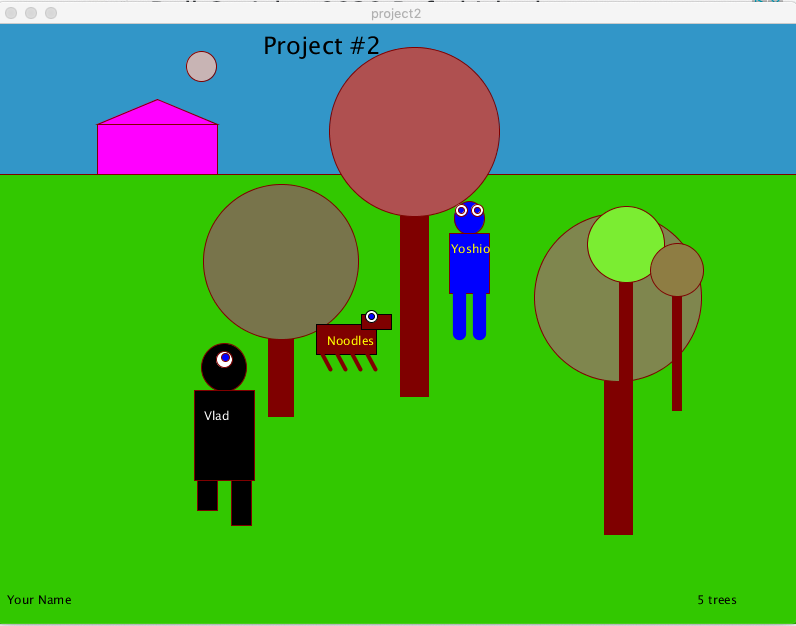
Click to enlarge screenshot.

Click to enlarge screenshot. |
Write new object-based code
to satisfy the requirements in
Project #1
& exam
q1 ,
plus some additional requirements (below).
In your folder, submit your code by April 1,
in a .pde file whose name begins with p2.
NOTE:
Do not copy your p1 code.
Instead, use it as a guide to write new object-based code,
using class definitons for:
Each class should include declarations for necessary properties
as well as a show() method
to display itself on the screen (with animation if required),
plus other methods, as needed.
// You may use different names for these classes, if you wish.
// (I changed my class name from "Sun" to "Star", to avoid confusion.)
Objects that move
will need either a move( ) method OR a chase( x2, y2 ) method.

MODIFICATIONS:

 Animate at least one of the moving objects (Hero, Dog, or Monster).
Animate at least one of the moving objects (Hero, Dog, or Monster).

 More features will be added here.
More features will be added here.

 BUTTONS
--
Add the following buttons to Project #2.
BUTTONS
--
Add the following buttons to Project #2.
|
similar to the one in h1b_buttons.pde | |
| HOME | move the hero to the house. |
|---|---|
| RESET | reset all objects. |
| DAY | switch to daytime. |
| NITE | switch to nighttime. |
Suggestion:
test these
in keyPressed(),
before connecting them to buttons. | |
ARRAYS & LOOPS (see Chapter 9):
Project #2 will also require an array for the 3 trees,
and a for loop to display them.
NOTE:
Rows of flowers & rocks
(from q1)
are not required;
code for these may be removed.
OPTIONAL -- Here are some ideas for extra credit:
//// CST 112 Project #2 / Your Name //// String title= "Project #2"; String author= "Your Name"; Hero yoshio; Dog noodles; Monster vlad; Star sol; House home; int ntrees=3; Tree[] trees = new Tree[ntrees]; boolean day=true; float horizon;// . . . (more declarations) . . . |
Your Object-Oriented Project #2 may include code similar to the following.
void setup() {
size( 800, 600 );
horizon= height / 4;
// Instatiation of objects. //
yoshio = new Hero();
noodles = new Dog();
vlad = new Monster();
sol = new Star();
for (int n=0; n<ntrees; n=n+1) {
trees[n] = new Tree();
}
home = new House();
// . . . (more setup) . . .
reset();
}
void reset() {
yoshio.reset();
monster.reset();
for (int n=0; n<ntrees; n=n+1) {
trees[n].reset();
}
}
void draw() {
scene();
action();
messages();
}
// . . .
| void scene() {
if (day) background( SKY );
else background( NITE );
sol.show();
grass();
ladder();
for (int n=0; n<ntrees; n=n+1) {
trees[n].show();
}
home.show();
// . . .
}
|
yoshio.move();
noodles.chase( yoshio.x, yoshio.y );
if ( ! day ) vlad.chase( noodles.x, noodles.y );
// . . . more action code . . .
|

class Star {
// MEMBER DATA. //
float x=0, y=50, dx=1, dy=0; // Position and speed.
float w=30, h=30; // Width & Height of ellipse.
color c = color(255,255,0); // Yellow. (Changes at nite.)
// METHODS //
void show() {
if (day) c = color(255,255,0); // Yellow sun.
else c = color(200,180,180); // Pale moon.
fill(c);
ellipse( x,y, w,h );
}
void move() {
if (x > width) { sunset(); } // Night & Day.
x = x + dx;
y = y + dy;
}
void sunset() {
day = ! day; // Switch nite/day
x = 0; // Reset to left
}
}
|
class Monster {
// MEMBER DATA. //
float x=0, y=50, xx=1, yy=0; // Position & speed.
// . . .
void chase( float x2, float y2 ) {
if ( day ) { return; } // No day chasing.
// Slowly chase (x2,y2)
xx = (x2-x) / 120;
yy = (y2-y) / 120;
move();
}
void move() {
x = x + xx;
y = y + yy;
}
// . . .
}
|